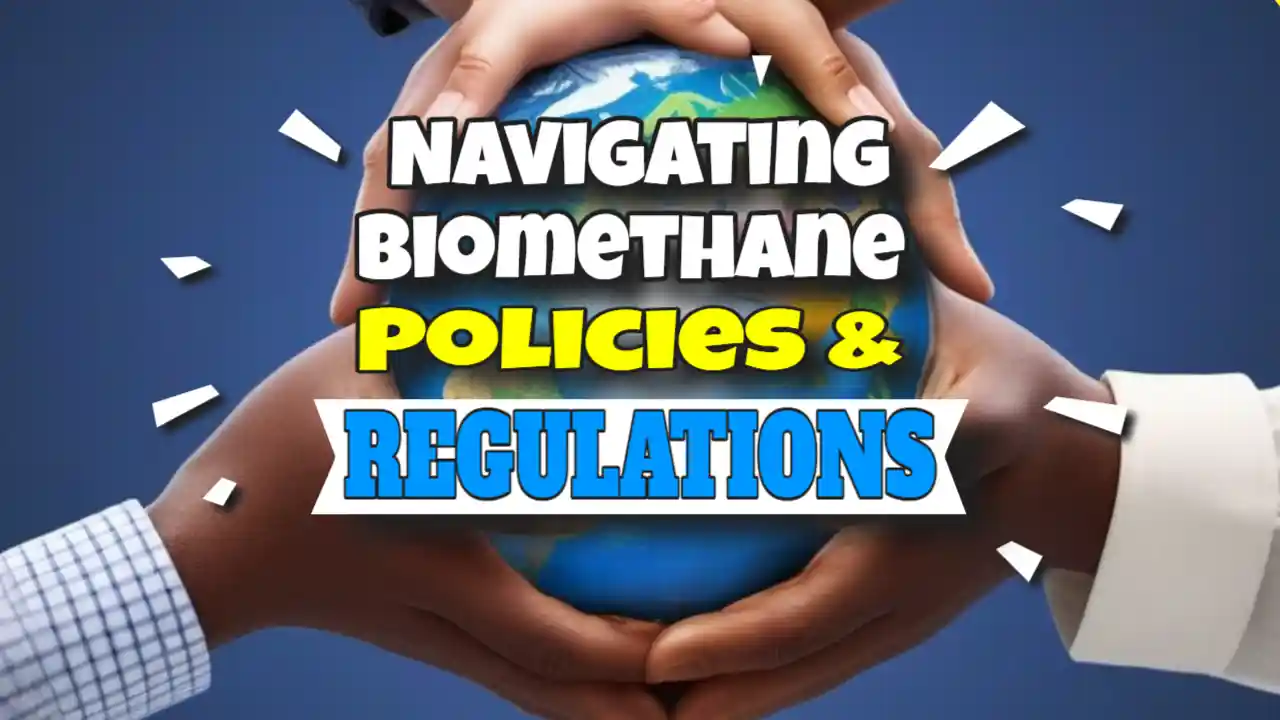Biomethane: What is it? As the world grapples with climate change and energy sustainability, the shift towards renewable resources like biomethane is not just a trend—it’s a necessity. Are you ready to uncover how this renewable gas can transform our energy landscape and contribute to a greener planet?
What You Will Learn
- Biomethane is a renewable gas derived from organic materials, significantly reducing reliance on fossil fuels.
- The production of biomethane aids in waste management by converting agricultural, industrial, and municipal waste into energy.
- Understanding the difference between biogas and biomethane is crucial, as biomethane is a purified (upgraded) form of biogas that has a much higher concentration of methane suitable for various applications.
- Renewable Natural Gas (RNG) represents biomethane injected into gas pipelines, enhancing energy flexibility and sustainability.
- Anaerobic digestion is the primary process for creating biomethane, converting waste into both energy and nutrient-rich fertilizer.
- Current trends show increased investment and supportive government policies driving the growth of the biomethane market globally.
- Emerging technologies in biomethane production are improving efficiency and cost-effectiveness, shaping the future of renewable energy.
- Robust infrastructure development is essential for the successful transportation and distribution of biomethane to end-users.
- Local engagement and educational resources are available for those interested in exploring the biomethane economy further.
Understanding Biomethane: A Comprehensive Overview

Biomethane is a fascinating and vital part of our energy landscape. It is a renewable gas produced from organic materials, making it a sustainable alternative to fossil fuels. By harnessing this resource, we can significantly reduce our dependence on non-renewable energy sources and contribute to a greener planet.
The significance of biomethane lies in its ability to produce energy while simultaneously addressing waste management issues. Through the conversion of agricultural, industrial, and municipal waste, biomethane not only serves as a source of energy but also helps in minimizing landfill contributions and greenhouse gas emissions. This dual benefit makes biomethane an integral player in the fight against climate change.
Defining Biomethane and Its Significance
Biomethane is essentially a purified form of biogas, consisting mainly of methane (CH4) and carbon dioxide (CO2). It can be used just like natural gas, contributing to electricity generation, heating, and as a vehicle fuel. The shift towards biomethane is crucial for achieving energy sustainability and climate action goals.
The significance of biomethane also extends to economic growth. By investing in biomethane projects, countries can create jobs, stimulate local economies, and promote energy independence. As the world shifts to cleaner energy sources, biomethane is poised to play a critical role in this transformation.
- Renewable energy source
- Supports waste management
- Contributes to local economies
- Aids in greenhouse gas reduction
- Can be used to achieve Net Zero climate change emissions targets.
Biogas vs. Biomethane: Key Differences Explained
While biogas and biomethane are often mentioned together, they are not the same. Biogas is a mixture of gases produced through the anaerobic digestion of organic matter, while biomethane is the upgraded version of biogas that contains a higher concentration of methane. Understanding this distinction is important for recognizing the potential applications of each.
Biogas typically contains around 50-70% methane, along with other gases like carbon dioxide, hydrogen sulfide, and trace amounts of other gases. In contrast, biomethane is refined to contain at least 95% methane. This increased purity makes biomethane suitable for direct injection into gas grids and use as a vehicle fuel.
Biogas vs. Biomethane Comparison
Renewable Natural Gas (RNG): A Key Component of the Biomethane Economy
Renewable Natural Gas (RNG) is another term closely linked to biomethane. RNG is essentially biomethane that has been injected into the natural gas pipeline system, allowing it to be distributed to homes and businesses. This makes it a flexible energy option that can easily integrate with existing infrastructure.
The integration of RNG into the energy market represents a significant step toward sustainability. By replacing fossil fuels with RNG, we reduce carbon emissions and enhance energy security. This helps fulfill local, national, and global energy needs while promoting a cleaner environment.
- Integrates with existing natural gas systems
- Reduces dependence on fossil fuels
- Helps meet renewable energy mandates
- Provides a stable energy source
Production Processes: How Biomethane is Created
Understanding how biomethane is produced is essential for appreciating its value. The primary method for creating biomethane is through a process called anaerobic digestion. In this process, microorganisms break down organic material in the absence of oxygen.
Anaerobic digestion not only produces biomethane but also results in digestate, which can be used as a nutrient-rich fertilizer, closing the loop in waste management. This method allows us to transform waste into a valuable resource, showcasing the circular economy in action.
Market Trends: Current Status and Future Outlook for Biomethane
The biomethane market is evolving rapidly, driven by a combination of environmental awareness and increasing energy demand. Countries are recognizing the potential benefits of biomethane, leading to a surge in production and investment. As we look at current trends, it’s exciting to see how this renewable energy source is gaining traction on a global scale!
Several factors are influencing the future of biomethane, including policy frameworks that support sustainable energy initiatives. Governments are implementing regulations to encourage the use of biomethane, making it an attractive option for both investors and consumers. By understanding these trends, we can better appreciate the role of biomethane in our energy landscape.
- Increased investment in biomethane production facilities
- Supportive government policies promoting renewable energy
- Growing consumer demand for sustainable energy solutions
Geographical Production Trends and Policy Frameworks
Biomethane production is not uniform across the globe; it varies significantly by region. Some areas have embraced biomethane as a viable energy source, while others are still developing their frameworks. Understanding these geographical differences helps us identify opportunities for growth and collaboration!
Countries like Germany and the United States are leading the way in biomethane production due to supportive policies and incentives. On the other hand, many developing nations are starting to explore biomethane as a part of their renewable energy strategies. Here are some key trends:
- Leading countries in biomethane production: Germany, US, UK, and Italy
- Emerging markets: India, Brazil, and China exploring biomethane potential
- Policies focusing on reducing carbon emissions and promoting waste management
Emerging Technologies Shaping the Biomethane Landscape
Innovative technologies are crucial for enhancing biomethane production and usage. As research continues, we’re seeing exciting advancements that make the process more efficient and cost-effective. These technologies not only improve production rates, but also support the overall sustainability of biomethane!
Some of the key waste technologies making waves in this field include advanced anaerobic digestion systems and biogas upgrading technologies. Staying informed about these innovations can provide insights into the future of biomethane and its potential impact on our energy systems.
- Enhanced anaerobic digestion techniques for greater efficiency
- Advanced biogas upgrading for high-purity biomethane
- Smart grid technologies integrating biomethane into existing infrastructure
Infrastructure Development and Economic Viability of Biomethane Projects
The success of biomethane projects heavily relies on robust infrastructure development. Proper infrastructure ensures efficient transportation and distribution of biomethane to end-users. As we look at the economic viability, investment in infrastructure is crucial for realizing the full potential of biomethane!
Several factors contribute to the economic feasibility of biomethane projects, including technology costs, feedstock availability, and market demand. By fostering collaboration between public and private sectors, we can create a supportive environment for these initiatives to flourish.
- Investment in distribution networks for biomethane
- Partnerships between governments and private companies
- Incentives for developing biomethane infrastructure
Common Acronyms for Biomethane
| Name | Description | Feature |
|---|---|---|
| RNG (Renewable Natural Gas) | Processed and purified biomethane | Interchangeable with natural gas |
| CBG (Compressed BioGas) | Biomethane compressed to high pressure | Used for transportation fuel or stationary applications |
| rLNG (Renewable Liquefied Natural Gas) | Biomethane cooled & compressed to liquid state | Efficient for long-distance transportation |
| Bio-LNG | Liquefied biomethane | Same benefits as LNG |
| rGTL (Gas-to-Liquid) | Converts biomethane into liquid fuels | Produces cleaner-burning synthetic fuels |
| rLCNG (Renewable Liquefied Compressed Natural Gas) | Combination of compression and liquefaction | Efficient storage and transportation |
Engagement and Further Learning Opportunities
For those interested in diving deeper into the world of biomethane, there are numerous avenues to explore. Engaging with local initiatives and educational resources can provide valuable insights and connections. The more we learn, the better we can contribute to the biomethane economy!
Participating in workshops, conferences, and community programs can enhance your understanding and open doors to collaboration. Here are some resources you might consider:
- Local biomethane workshops and seminars
- Online courses focused on renewable energy and biomethane
- Networking events with industry professionals
Frequently Asked Questions About Biomethane
As interest in biomethane grows, so do the questions surrounding it. Addressing common queries helps demystify this renewable energy source and encourages more people to get involved. Below are some frequently asked questions to enhance your understanding!
What Feedstocks are Commonly Used for Biomethane Production?
The choice of feedstock plays a pivotal role in the efficiency and output of biomethane production. Various organic materials can be used, which can impact production yields and costs. Here are some common feedstocks:
- Agricultural residues (e.g., corn stover, straw)
- Animal manures (e.g., dairy and poultry waste)
- Food waste from households and restaurants
How Does Biomethane Contribute to Energy Security?
Biomethane strengthens energy security by diversifying energy sources and reducing dependence on fossil fuels. By producing energy locally, communities can enhance their resilience against energy price fluctuations. This localized approach contributes significantly to a sustainable energy future!
What Role do Renewable Energy Certificates (RECs) Play in Biomethane?
Renewable Energy Certificates (RECs) are essential in promoting the use of biomethane. They provide a market-based incentive for energy producers to generate renewable energy, ensuring that their contributions are recognized. This mechanism not only supports the growth of biomethane but also encourages the development of clean energy alternatives!
You May Like to Read Our Other Biomethane Articles Such as:
Conclusion and Next Steps
Understanding your role in the biomethane economy is vital for fostering a sustainable future. Whether you’re a consumer, business owner, or policy maker, there are numerous ways to engage with this growing sector. Consider what actions you can take to support biomethane initiatives in your community!
By getting involved with local biomethane projects, you can make a positive impact and help drive the transition to renewable energy. Let’s work together to harness the potential of biomethane for a cleaner, greener planet!





Leave a Reply